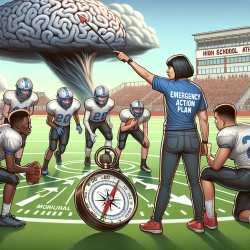Introduction
High school sports are not just about building physical strength and teamwork; they're also about nurturing mental resilience. In today's world, student athletes face a unique set of challenges that can impact their mental health. A recent research article titled "Considerations for Developing a Mental Health Emergency Action Plan for High School Football Programs and Athletic Departments" provides valuable insights on how to better support these young athletes.
Understanding the Need
High school football players, in particular, are at higher risk for mental health issues due to the pressures of competition, risk of injury, and the high stakes environment they operate in. This can lead to issues such as anxiety, depression, and burnout. To address these challenges, it's crucial for athletic departments to develop a Mental Health Emergency Action Plan (MHEAP).
Key Components of a Mental Health Emergency Action Plan
Creating a MHEAP involves several key steps:
- Identify Mental Health Emergencies: Recognize the signs of mental health crises, such as rapid mood swings, withdrawal, or suicidal ideation.
- Develop Response Procedures: Outline clear steps for managing emergencies, including who to contact and how to provide immediate support.
- Engage a Crisis Team: Form a team of school personnel, including counselors, coaches, and nurses, who are trained to handle mental health crises.
- Legal Considerations: Ensure compliance with privacy laws and school regulations when involving parents or guardians.
- Local Resources: Identify local mental health resources and establish partnerships for ongoing support.
Implementing the Plan
Once the plan is developed, it’s essential to train all stakeholders, including coaches, trainers, and school staff, to recognize and respond to mental health issues. Regular drills and reviews of the plan can help ensure everyone is prepared.
Encouraging a Supportive Environment
Beyond emergency planning, fostering a supportive environment is key. Encourage open communication about mental health, reduce stigma, and promote help-seeking behavior among student athletes. This can be achieved through workshops, peer support programs, and mental health awareness campaigns.
Conclusion
By implementing a Mental Health Emergency Action Plan, high school athletic departments can provide a safer and more supportive environment for student athletes. This not only helps in crisis situations but also promotes overall well-being and resilience among young athletes.
To read the original research paper, please follow this link: Considerations for Developing a Mental Health Emergency Action Plan for High School Football Programs and Athletic Departments.










